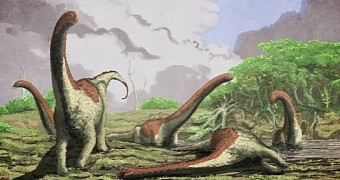A paper published in yesterday's issue of the Journal of Vertebrate Paleontology announces the discovery of the fossilized remains of a previously undocumented dinosaur species in present-day Tanzania.
Following an analysis of these fossilized bones, paleontologists concluded that the newly discovered species, now known as Rukwatitan bisepultus, walked the Earth about 100 million years ago.
These giants belonged to a group of dinosaurs known as titanosaurian sauropods. Remains of other creatures belonging to this group have until now been unearthed all around the world, and especially in South America.
Not an easy dig
As detailed in the Journal of Vertebrate Paleontology, the fossilized remains that led to the discovery of this new dinosaur species were found not buried in the ground in Tanzania, but embedded in a cliff wall in the country's Rukwa Rift Basin.
In order to get their hands on them, and thus be able to give them a proper scrub and analyze their anatomical particularities, paleontologists had to call in professional excavators and miners, and have them pull the remains from the cliff wall. Luckily, things turned out more than OK in the end.
A species' profile
As mentioned, Rukwatitan bisepultus lived about 100 million years ago, during the middle of the Cretaceous Period. Like the other titanosaurian dinosaurs thus far discovered by researchers, it was a vegetarian. Still, adults belonging to this species were nothing short of impressive size-wise.
According to Eric Gorscak, a doctoral student at Ohio University in the US, these dinosaurs had a weight comparable to that of several elephants put together. Besides, they had necks measuring as much as 2 meters (roughly 6.5 feet) in length.
As noticeable in the image accompanying this article, Rukwatitan bisepultus was also quite thick around the waistline. Its shoulders were rather broad, and there is little doubt that, despite the fact that it was a vegetarian, it was pretty scary to look at from a distance, let alone cross paths with.
The implications of this find
Given the fact that titanosaurian sauropod fossilized remains have until now been unearthed all around the globe, the discovery of these bones in present-day Tanzania should help paleontologists better understand the diversity of this group of ancient giants. More so since, oddly enough, not all that many titanosaurian sauropod remains have until now been discovered in Africa.
“Much of what we know regarding titanosaurian evolutionary history stems from numerous discoveries in South America – a continent that underwent a steady separation from Africa during the first half of the Cretaceous Period,” says Eric Gorscak.
“With the discovery of Rukwatitan and study of the material in nearby Malawi, we are beginning to fill a significant gap from a large part of the world,” the doctoral student goes on to explain.

 14 DAY TRIAL //
14 DAY TRIAL //